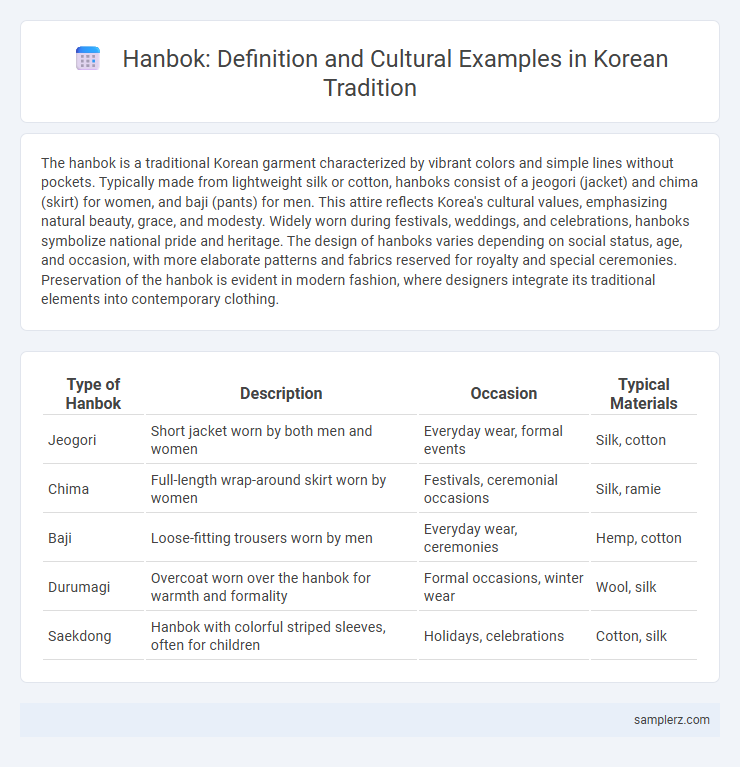The hanbok is a traditional Korean garment characterized by vibrant colors and simple lines without pockets. Typically made from lightweight silk or cotton, hanboks consist of a jeogori (jacket) and chima (skirt) for women, and baji (pants) for men. This attire reflects Korea's cultural values, emphasizing natural beauty, grace, and modesty. Widely worn during festivals, weddings, and celebrations, hanboks symbolize national pride and heritage. The design of hanboks varies depending on social status, age, and occasion, with more elaborate patterns and fabrics reserved for royalty and special ceremonies. Preservation of the hanbok is evident in modern fashion, where designers integrate its traditional elements into contemporary clothing.
Table of Comparison
| Type of Hanbok | Description | Occasion | Typical Materials |
|---|---|---|---|
| Jeogori | Short jacket worn by both men and women | Everyday wear, formal events | Silk, cotton |
| Chima | Full-length wrap-around skirt worn by women | Festivals, ceremonial occasions | Silk, ramie |
| Baji | Loose-fitting trousers worn by men | Everyday wear, ceremonies | Hemp, cotton |
| Durumagi | Overcoat worn over the hanbok for warmth and formality | Formal occasions, winter wear | Wool, silk |
| Saekdong | Hanbok with colorful striped sleeves, often for children | Holidays, celebrations | Cotton, silk |
Traditional Hanbok Styles and Their Significance
Traditional hanbok styles, such as the jeogori (short jacket) and chima (wrap-around skirt) for women and baji (pants) for men, showcase Korea's rich cultural heritage and aesthetic principles. The vibrant colors and intricate patterns of hanbok symbolize social status, marital status, and occasion, reflecting deep-rooted Confucian values and Korean identity. Wearing hanbok during festivals and ceremonies preserves historical customs and promotes cultural pride.
Modern Interpretations of Hanbok
Modern interpretations of hanbok blend traditional Korean aesthetics with contemporary fashion, incorporating streamlined silhouettes and innovative fabrics. Designers experiment with vibrant colors and minimalistic patterns to make hanbok more accessible for everyday wear while preserving its cultural significance. This fusion has expanded hanbok's appeal, positioning it as a symbol of national identity and global fashion influence.
Hanbok in Korean Festivals and Celebrations
Hanbok, the traditional Korean dress, is prominently worn during major festivals such as Seollal (Lunar New Year) and Chuseok (Korean Harvest Festival), symbolizing respect for ancestors and cultural heritage. The vibrant colors and intricate designs of Hanbok reflect social status and embody centuries-old Korean aesthetics that enhance the celebratory atmosphere. Wearing Hanbok during these occasions strengthens communal identity and connects modern Koreans with their historical roots.
Symbolic Colors and Patterns in Hanbok
Hanbok features symbolic colors and patterns that reflect Korean cultural values and social status, with red symbolizing good fortune and happiness, while blue represents hope and longevity. Patterns such as phoenixes and peonies are commonly embroidered to convey nobility and prosperity. These elements combine to create garments that are not only aesthetically pleasing but also rich in meaning and tradition.
Regional Variations of Hanbok across Korea
Hanbok exhibits distinct regional variations across Korea, with styles reflecting local climate, customs, and materials. For example, Jeju Island's hanbok features lighter fabrics and muted colors suited for its coastal environment, while the Jinju region is known for intricate embroidery and bolder hues symbolizing its historical significance. These regional differences not only highlight Korea's diverse cultural heritage but also preserve unique identities through traditional clothing.
Hanbok for Different Social Classes in History
Hanbok, traditional Korean attire, varied significantly across social classes in historical periods, with noble families often wearing elaborate, richly embroidered garments made from silk and adorned with gold threads. Commoners typically donned simpler hanboks crafted from plain cotton or hemp, reflecting their modest economic status and daily labor needs. Royalty's hanbok featured vibrant colors and intricate designs symbolizing power and rank, distinguishing their social hierarchy through clothing aesthetics.
Iconic Hanbok Worn by Korean Royalty
The iconic hanbok worn by Korean royalty during the Joseon Dynasty featured vibrant silk fabrics, intricate gold embroidery, and symbolic patterns such as dragons and phoenixes representing power and prosperity. Royal hanboks typically consisted of a jeogori (jacket) paired with a chima (skirt) for queens or a durumagi (overcoat) for kings, emphasizing status and authority through color and design. These garments not only reflected the wearer's rank but also held cultural significance in ceremonies like weddings and royal rituals.
Famous Hanbok Designers and Influential Collections
Hanbok designers like Lee Young-hee and Kim Yong-bae have redefined traditional Korean attire through innovative collections that blend modern aesthetics with cultural heritage. Lee Young-hee's exhibition at the Metropolitan Museum of Art showcased intricate embroidery and vibrant colors, influencing global fashion perspectives on hanbok. Kim Yong-bae's "Beyond Hanbok" collection introduced contemporary silhouettes, making hanbok more accessible and popular among younger generations.
Hanbok in Contemporary Korean Pop Culture
Hanbok, the traditional Korean attire, has been reimagined in contemporary Korean pop culture through vibrant designs and modern fabrics, frequently featured in K-pop music videos and fashion runways. Popular idols like BTS and BLACKPINK incorporate Hanbok elements to celebrate Korean heritage while appealing to global audiences, blending tradition with contemporary styles. This fusion highlights Hanbok's evolving symbolism as both a cultural emblem and a dynamic fashion statement in the modern entertainment industry.
How to Wear and Accessorize Hanbok Properly
Wearing hanbok properly involves draping the jeogori snugly around the torso and securing the goreum (ribbon) with a neat bow on the right side. The chima should be wrapped high above the waist to create an elegant silhouette, while baji pants are tied comfortably at the ankles. Accessorizing with traditional norigae tassels and beoseon socks enhances the cultural authenticity and aesthetic appeal of hanbok attire.

example of hanbok in Korean Infographic
 samplerz.com
samplerz.com